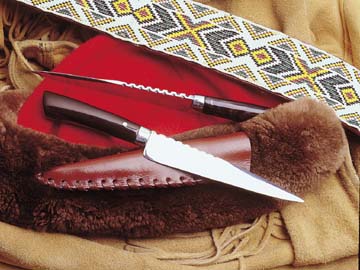A number of Scottish blades, dirks and sgians especially, have file-work on the spines of the blade, like this example:
[ Linked Image ]
We rarely see front and back sides of blades, though, in museum catalogues. Is it safe to assume the file-work is on both sides of the blade? Can anyone confirm that? Perhaps there are examples with one side filed as well as examples with both.
| Chad Arnow wrote: |
| A number of Scottish blades, dirks and sgians especially, have file-work on the spines of the blade, like this example:
[ Linked Image ] We rarely see front and back sides of blades, though, in museum catalogues. Is it safe to assume the file-work is on both sides of the blade? Can anyone confirm that? Perhaps there are examples with one side filed as well as examples with both. |
For whatever its worth, I've seen a few examples in hand that have them on the front and back. I haven't seen any with them only on one side, but I've had a very small sampling, so that doesn't necessarily mean anything. I think I've only handled five antique Scottish knives total, or roughly around that amount.
I think if you examine the size of the half-moon filing marks on the pictured example of a Sgian Achlais, you will see that the spaces in between the filings are narrower than the filing designs themselves, making it unlikely that the opposite side of the blade would have similar markings - there simply wouldn't be enough space. That being said, I think it is likely that a knife's decoration could be either one-sided or two-sided, depending on the maker's whim, but on a pratical side, should the filing be used to aid gripping the blade to give better purchase for a thumb, it would only need to be on one side, given which handedness the knife was made for.
I own one of Old Dominion Forge's Sgian Achlais knives, as well as a Dirk, and they both are filed only on one side of the blade, and in a place where the thumb of the right hand can easily rest there to give better grip or control when carving. I also have several of Glenn McClain's fine Scotish knives, and he crafts them all to have file work equally on both sides of the blade back, usually near the rear spine. I'm sure he makes his more for decoration, but it does give them a decidedly more versatile griping option when working up close with the blade.
Just my own 2 cents. :)
I own one of Old Dominion Forge's Sgian Achlais knives, as well as a Dirk, and they both are filed only on one side of the blade, and in a place where the thumb of the right hand can easily rest there to give better grip or control when carving. I also have several of Glenn McClain's fine Scotish knives, and he crafts them all to have file work equally on both sides of the blade back, usually near the rear spine. I'm sure he makes his more for decoration, but it does give them a decidedly more versatile griping option when working up close with the blade.
Just my own 2 cents. :)
I recall seeing an edge-on view of the back of such a blade, and the jimping was on both sides but alternating--the flat of one side corresponded to the file work on the other, etc. Like this one, currently on sale at Atlanta Cutlery for only $29.00! I don't like the grip, but that's easily swapped for stag.
 Attachment: 28.24 KB
Attachment: 28.24 KB


What I have seen, both in reproductions and a few originals, is file-mooned on both sides (is that called "jimping"?), with the moons staggered or offset from side to side (which is what is depicted in the Atlanta Cutlery example, above).
I had presumed that it was always both sides as a result.
I'd be interested to know if it were otherwise (since I'm looking at my first knife-finishing project).
I had presumed that it was always both sides as a result.
I'd be interested to know if it were otherwise (since I'm looking at my first knife-finishing project).
This dirk type is also illustrated in John Wallace's "Scottish Swords and Dirks" p.77.
Page 1 of 1
You cannot post new topics in this forumYou cannot reply to topics in this forum
You cannot edit your posts in this forum
You cannot delete your posts in this forum
You cannot vote in polls in this forum
You cannot attach files in this forum
You can download files in this forum
All contents © Copyright 2003-2006 myArmoury.com — All rights reserved
Discussion forums powered by phpBB © The phpBB Group
Switch to the Full-featured Version of the forum
Discussion forums powered by phpBB © The phpBB Group
Switch to the Full-featured Version of the forum